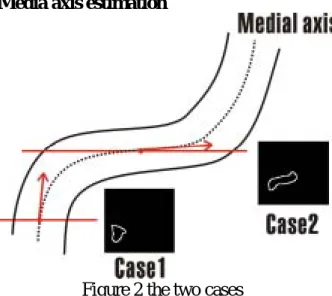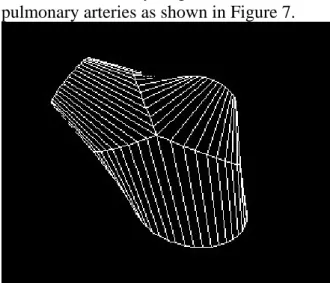行政院國家科學委員會補助專題研究計畫成果報告
※※※※※※※※※※※※※※※※※※※※※※※※※
※ ※
※ 自心臟高速斷層掃描重建準確大動脈之研究 ※
※ ※
※※※※※※※※※※※※※※※※※※※※※※※※※
計畫類別:X 個別型計畫 □整合型計畫
計畫編號:NSC89-2213-E009-177- -
執行期間: 89 年 8 月 1 日至 90 年 7 月 31 日
計畫主持人:荊宇泰
共同主持人:
本成果報告包括以下應繳交之附件:
□赴國外出差或研習心得報告一份
□赴大陸地區出差或研習心得報告一份
□出席國際學術會議心得報告及發表之論文各一份
□國際合作研究計畫國外研究報告書一份
執行單位:交通大學資訊科學系
中 華 民 國 91 年 1 月 1 日
行政院國家科學委員會專題研究計畫成果報告
國科會專題研究計畫成果報告撰寫格式說明
Preparation of NSC Project Reports
計畫編號:NSC 89-2213-E-009-117
執行期限:89 年 8 月 1 日至 90 年 7 月 31 日
主持人:荊宇泰 交通大學資訊科學系
共同主持人:
計畫參與人員:
一、中文摘要 在本計畫中,我們設計發展一個自心臟斷 層掃描影像建立肺動脈幾何模型的方法。 對於該幾何模型,我們要求其表面由四邊 形網格所構成。本計畫困難處有二,一是 CT 影像中,z 方向解析度較差,二是要求 結構為四邊型網格。我們研發的方法主要 步驟有二,首先我們計算出肺動脈中軸的 位置,接著我們在推算肺動脈的管徑。最 後再根據這兩項資訊建立幾何模型。我們 以一組 phantom data 做測試,本方法可以 得到理想結果。 關鍵詞:心臟高速斷層掃描,3D 立體模型重 建 AbstractWe construct the geometric model for the pulmonary artery from a set of electron beam cardiac CT scan. We also need the model is in rectangular meshes. The main difficulties in this work are insufficient resolution along z-direction and the requirement of the rectangular meshes. We present a method that is based on estimation the medial axis and the radii of the vessel along the axis. We verify the proposed using a phantom data set. The proposed method can achieve good reconstructed result for the phantom data set.
Keywords: cardiac CT scan, 3D model
reconstruction.
二、Introduction
Cardiac CT scan is one of the most important tools for heart disease diagnosis. It has the advantage that the resolution of an image is the best among all of the modalities. Due to this reason, this work constructs the 3D geometric model of the pulmonary arteries from a set of CT images. This is a preparation for fluid dynamics analysis of the flow in the pulmonary arteries. For this reason, the geometric model must meet the following criterion.
1. The meshes are rectangular.
2. The direction of the rectangular meshes should consistent with the medial axis of the vessel.
These requirements make the task a difficult task. Another difficulty is due to the relative low resolution along z –direction.
In this report, we present a method that reconstructs the geometric model to meet the requirements stated above. The presented method is divided into three steps. The first step is preprocessing of the images. In the second step, we compute the medial axis of the pulmonary. And in the third step we construct the geometric model.
2. Method
We assume that the pulmonary artery (PA) consists of two tubes. The LPA and PT is a tube and the RPA and PT is another tube. The boundary points in these pair of tubes in the CT images are identified by user assistant.
Figure 1. The pulmonary artery
These pair of tubes are reconstructed by first identifying the media axis. We then estimate the radii of the tube along the media axis.
Media axis estimation
Figure 2 the two cases
There are two cases as shown in figure 2.
Case1: Observe that, if a plane that is
almost perpendicular to the media axis of a tube, the intersection of the tube with the
plane should be closed to an ellipse. We approximate the contour obtained by an ellipse. The center point of the ellipse is an estimation of a point on the medial axis. The length of the short axis is the radius of the tube centered at the point. Furthermore, the orientation of the plane that is perpendicular to the media axis can be found about rotating about the short axis. The angle of rotation is obtained from the ratio of the length of the long axis and the short axis.
Figure 3 Find the plane that is almost perpendicular to the media axis.
Case 2: If the plane is almost parallel to
the media axis. We find parallel planes that are perpendicular to the contours as shown in Figure 3. The intersection of a plane and the contours can be approximated using an ellipse. We then have the case that is the same as case 1. We use the same method mentioned above to estimate the point on the media axis, the radius, and the true orientation of the plane.
The next step is to construct the media axis for a tube. We first connect the points along the media axis to for a polygonal path. We the approximate the polygonal path using a spline curve as shown in Figure 4.
Figure 4 The polygonal path of the estimated polygonal path and the spline approximation.
Recall that, we have a pair of tubes which are respectively LPA + PT and RPA + PT. That means the pair of spline curve should be merged at PT to obtain a three-branche pulmonary arteries. The
merged paths are as shown in Figure 5.
Figure 5 The merged media axis
The merging process is carried out by designing the junction of the branch which is as shown in Figure 6.
Figure 6 the designed junction. Finally, we connect LPA, RPA, and PT to form the boundary representation of the pulmonary arteries as shown in Figure 7.
Figure 7 The constructed junction.
3 Result
The method was applied to reconstruct the
pulmonary arteries from a set of CT images. The result is shown in Figure 8.
Figure 8 the reconstructed pulmonary arteries
In order to verify the accuracy of the proposed method, we built a phantom data set. We filled contrast agent into a hose. We then took CT scan of the hose. Since we know the radius of the hose, we can evaluate the accuracy of the proposed method. Figure 9 shows the phantom data obtained from the volume rendering of the volume data. Figure 10 shows the reconstructed tube by using the proposed method.
Figure 9 the image obtained using the volume rendering of the volume data.
Figure 10 The reconstructed hose
4 References
[1] Harsh Shroff and Jezekiel Ben-Arie ,
“Finding Shape Axes Using Magnetic Fields,” IEEE Trans. on Image Processing, Vol. 8, No. 10, pp. 1388 – 1394, OCTOBER 1999
[2] H. Blum, “A transformation of extracting new descriptors of shape,” in Proc. Symp. Models for the Perception of Speech and Visual Form. Cambridge, MA: MIT Press, 1964
[3] ANDR⊃ GU⊃ZIE∗ AND NICHOLAS AYACHE, “Smoothing and Matching of 3D Space Curves,” International Journal of Computer Vision, 12:1, pp. 79-104, 1994
[4] Andrew Fitzgibbon, Maurizio Pilu, and Robert B. Fisher, “Direct Least Square Fitting of Ellipse,” IEEE TRANSACTION ON PATTERN ANAYSIS AND MACHINE INTELLIGENCE, Vol. 21, No. 5, pp. 476-480, MAY 1999
[5] Sung Joon Ahn, Wolfgang Rauh and Matthias Recknagel, “Ellipse Fitting and Parameter Assessment of Circlar Object Targets for Robot Vision,” Proceedings of the 1999 IEEE/RSJ International Conference on Intelligent Robots and Systems, pp. 525- 530, 1999
[6] Karl Krissian, Grégoire Malandain and Nicholas Ayache, “Model-based Detection of Tubular Structures in 3D Images,” Computer Vision and Image Understanding 80, pp. 130-171, 2000
[7] Karl Krissian and Régis Vaillant, “Automatic and accurate measurement of a cross-sectional area of vessels in 3D x-ray angiography images,” Proc. Of SPIE Vol. 3979, Image Processing, pp. 676-686, Feb 2000

